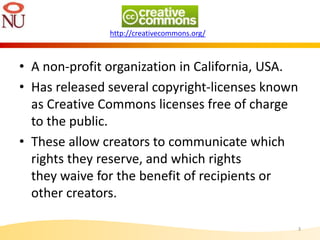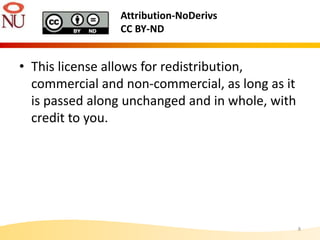Introduction to Open content licensing
- 1. Introduction to Open Content Licensing Akhlesh Agarwal 24 Apr 2014 1
- 2. 2
- 3. • A non-profit organization in California, USA. • Has released several copyright-licenses known as Creative Commons licenses free of charge to the public. • These allow creators to communicate which rights they reserve, and which rights they waive for the benefit of recipients or other creators. 3 http://creativecommons.org/
- 4. 4
- 5. 5
- 6. • This license lets others distribute, remix, tweak, and build upon your work, even commercially, as long as they credit you for the original creation. This is the most accommodating of licenses offered. Recommended for maximum dissemination and use of licensed materials. 6 Attribution CC BY This is the default license for Youtube videos https://support.google.com/youtube/answer/2797468
- 7. • This license lets others remix, tweak, and build upon your work even for commercial purposes, as long as they credit you and license their new creations under the identical terms. This is the license used by Wikipedia, and is recommended for materials that would benefit from incorporating content from Wikipedia and similarly licensed projects. 7 Attribution – Share Alike CC BY - SA
- 8. Attribution-NoDerivs CC BY-ND • This license allows for redistribution, commercial and non-commercial, as long as it is passed along unchanged and in whole, with credit to you. 8
- 9. • This license lets others remix, tweak, and build upon your work non-commercially, and although their new works must also acknowledge you and be non-commercial, they don’t have to license their derivative works on the same terms. 9 Attribution-NonCommercial CC BY-NC
- 10. • This license lets others remix, tweak, and build upon your work non-commercially, as long as they credit you and license their new creations under the identical terms. 10 Attribution-NonCommercial-ShareAlike CC BY-NC-SA Khan Academy and NPTEL content is licenced under this license https://www.khanacademy.org/about/tos#7 http://nptel.ac.in/pdf/CC%20LIcenseNotes.pdf
- 11. • This license is the most restrictive of six main licenses, only allowing others to download your works and share them with others as long as they credit you, but they can’t change them in any way or use them commercially. 11 Attribution-NonCommercial-NoDerivs CC BY-NC-ND
- 12. 12
- 13. Fair use 13 • A limitation and exception to the exclusive right granted by copyright law to the author of a creative work. • A set of tacit guidelines and conventions that enable users to use part of the copyrighted material without formal consent of the original creator. Fair use is limited to a very strict and specific purposes including" criticism, comment, news reporting, teaching (including multiple copies for classroom use), scholarship, or research." http://en.wikipedia.org/wiki/Fair_use
- 15. Conclusion • We can reuse most* material downloaded from internet, if: – We mention the creator of the material (Person / URL). – Use it for non commercial purpose (teaching NU students) – Use it on our internal network Moodle only (not upload on YouTube or other external sites). 15 (*): Disclaimer : This is based on limited study of available material. There may be some situations in which this conclusion may not hold completely. Please seek additional legal opinion. Author of the document will not be responsible for any financial damages in case of legal dispute.
- 16. Thank you 16















